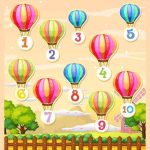Kids love exploring how things work—and fridge magnets are often a favourite! That’s because there is something irresistibly fun about how they defy gravity and seem to ‘stick’ like magic. It’s a simple but fascinating experience that feels like a mini-science experiment every time. But even if your child hasn’t shown much interest yet, magnetic play can be a surprisingly fun way to introduce hands-on science in everyday moments. In this blog, we will explore some fun and exciting activities to keep your kids engaged and entertained.
Magnetic Exploration Activities for Kids
Here are some pretty amazing things to do with magnets:
- Magnetic Discovery Bottles
- Iron Filing Art
- Mini Magnet Maze
- Create a maze on a piece of paper. The difficulty level of the maze should be kept to your child’s age.
- Glue one magnetic button to a popsicle stick to create a ‘magnetic wand’.
- Placing a separate magnetic button on top of the maze, hold the wand underneath the paper and navigate it through those twists and turns.
- Is This Magnetic?
- Magnetic Painting
- Magnets All Around Us
- Magnetic Fishing
- Make printouts of letters and numbers. Then, cut them out with scissors. Note: You want to do this ‘cutting’ job yourself.
- Let your child colour those cut outs, and glue paper clips to each one.
- Make a fishing pole. This is easy. Attach a button magnet to the string and tie it to a popsicle stick.
- Have your child fish for those paper cut outs with that’ pole’. Bonus: This is a great exercise to teach them letters and numbers, too.
- Jumping Magnets
- Place a long piece of masking tape on a table. Draw a red dot on the far end of the tape. This signifies the spot where the ‘Magnets’ will start.
- Place a magnetic object on the red dot.
- Placing a magnetic wand on the other end of that masking tape, move it slowly towards the magnetic object.
- Mark a spot on the tape where the object ‘jumps’ to reach the wand.
- Try several different objects to see which one jumps the farthest!
- Making your own Electromagnet
- Take a long piece of copper wire, and strip a small amount of copper insulation off it on both ends.
- Wrap the wire around a large nail.
- Make a circuit with the ends of the wire attached to the terminals of a lantern battery. Note: You can use alligator clips to connect and disconnect the wires.
- Before connecting the wires, let your children try picking up paper clips with simply the nail wrapped in wire. It won’t pick up any clips.
- Have a wire run from one battery terminal to the end of the wire around the nail.
- Another wire should run from the opposite end of the nail’s wire to the other battery terminal.
- Make sure all connections are secure.
- Once the circuit is complete, voila! You have your electromagnet.
- Magnetic Compass
- Filling a shallow bowl with water, label it with the four directions: North, South, East, West.
- Stick a paper clip to one end of a cork.
- Let your child forcefully rub a magnet against the paper clip. Tell them that by doing so, they are creating a magnet that might last a couple of minutes.
- Place that cork with the magnetized paper clip in the bowl.
- Get your child to notice the paper clip that will be facing north. Congratulate them on creating their very first makeshift compass!
This one makes playing with magnets a whole lot more interesting.
To do: Fill an empty bottle with rice or beans. Add magnetic and non-magnetic items, and shake it up. Your child must run a magnet along the outside of the bottle to move items inside it.
Have a budding artist at home? They will love magnet experiments for kids like this one.
To do: Place a magnet amongst iron filings and see the pattern formed, showing where the magnetic forces are at work.
Tip: Use different magnets to create different patterns. Let your child revel in creating fine works of magnetic art!
It is yet another fun activity with magnets for kids to indulge in.
To do:
Science experiments with kids entail using the scientific skills of investigation and prediction.
To do: Give your child a selection of objects, and ask them to make predictions vis a vis which they think are magnetic and those that are not. You will be surprised at what they bring up in this one!
This is yet another one of those magnetic experiments that brings out the artist in little ones.
To do: Place a piece of paper at the bottom of a shoe box. Then, place a few drops of paint and a paperclip on the paper. Tell your child to move a magnet underneath the box. They will get fascinated as they see how the colours blend together.
Your children will be surprised to learn how many magnetic objects are in their environment.
To do: Let them take a magnetic wand in their hands and go outdoors, for instance, to the park. Have them explore the vast number of objects their wand sticks to. We are guessing they will find more metallic surfaces than you might expect them to!
‘Fish’ is not the only thing you can go out there fishing for!
To do:
Another great Science Experiment with magnets.
To do:
A truly awesome Science Experiment, for older kids.
To do:
Creating their compass will delight kids!
To do:
Turning Playtime Into Learning Time-H2
Science doesn’t need a lab coat or complicated equipment. Sometimes, all it takes is a few fridge magnets and a curious child. Whether at home or in the classroom, simple, hands-on activities using everyday supplies can spark big learning moments. These fun with magnet experiments are perfect for toddlers and can easily be tailored to meet educational goals.
By introducing science through playful storytelling, you’re not just teaching facts—you’re inspiring imagination, encouraging problem-solving, and helping your child build a strong foundation for lifelong learning. After all, when learning feels like play, kids stay engaged, focused, and excited to explore the world around them. Looking for some fun and exciting summer activities for kids? Check out our blog, 11 Best Fun Summer Activities for Kids. Check out EuroKids Blogs for more insights on your little one’s learning and development.
At EuroKids, we believe that playing with magnets provides scientific fun for kids of all ages. Further, it also improves coordination and fine motor skills. We encourage all parents to get their children to indulge in Magnetic Play, through as many magnetic activities and experiments as possible.















